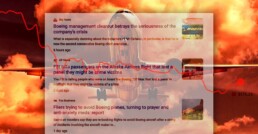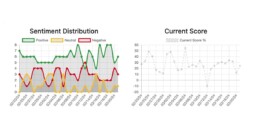Air travel sure ain’t what it used to be, but it’s always nice to arrive alive. Forget the seats designed for amputees or infants and food that’s worse than World War II K rations. Passenger confidence plummets when a door “plug” falls off an aircraft at 16,000 feet or a wheel drops from the landing gear, smashing cars parked below. When the hits keep on coming, as in the case of the only American large-scale passenger airplane maker over the last eight or nine weeks, it seems impossible for that company to even stay in business. And what about its reputation with crews, airline customers, investors, and passengers?

In the case of Boeing, not only has it remained in business, but thousands of its aircraft continue to fly passengers all around the globe, probably every minute. Its stock price is only a few dollars below where it was a year ago, although way off a mid-year high. But also astounding is that despite the calamitous crises befalling the company, its corporate reputation, while shredded, is still holding on to a “poor” level, or a positive 30 on a scale developed by Lightbox Search of positive 100 to negative 100. And even that score is not far off where it was 12 months ago. We’ve had some clients and measured some companies making far less headline-grabbing, near-fatal issues hit the negative 20s and even lower.
The company, which more than 100 years old, has built an effective internal communications team and retains excellent outside counsel, so it is handling its media coverage and search results extremely well, given the hits that keep coming. But it also has a lot more tailwind that very few companies and organizations do. That’s one of the benefits of being one-half of a global duopoly. Not many other companies or organizations are “too big to fail,” as the nation’s largest banks were regarded during the worst of the recession. Of course, it’s repeatedly made its mea culpa’s, apologized to passengers, replaced its CEO, and announced all manner of plans to improve quality control, but crises keep happening.
Despite avoiding the “terrible” category, the reputational damage is still massive and injects greater concerns and downright worry among passengers. Its stock is still way off its high of six months ago and probably will have a hard time rising for months if not years, to come. Boeing’s European competitor, Airbus, continues to gain market share, and more and more prospective flyers are checking to see what airplane is being flown for their next flight. But for the most part, Boeing’s backlog of orders from airlines around the world continues to build, and military orders keep rolling in.
Boeing’s Challenges
Boeing’s reputation wasn’t perfect before this, and the journey to rebuilding its online reputation has long been fraught with challenges for Boeing. The most significant blows came with grounding its 737 MAX fleet following the two fatal crashes in 2018 and 2019. These tragedies raised serious safety concerns and shook public trust in Boeing’s aircraft manufacturing processes. In two very recent “incidents,” a LATAM flight suddenly dropped 500 feet when, according to the company and the airline, a pilot’s electric seat control was “accidentally” pushed forward when he was being served his meal, pushing the nose down. In another incident, just in March 2024, a panel fell off a United plane flying from San Francisco to Portland, OR. We almost already forget when flames started shooting out of an engine on a United Flight – again in March.
Subsequent investigations and revelations of internal communication failures further ravaged Boeing’s image. The company faced criticism for prioritizing profits over safety and for inadequately informing regulators and customers about potential risks. In the crashes of five years ago, the company at first blamed insufficiently trained pilots. But then investigators and investigative journalists found out about software the company installed—without telling the public, let alone the pilots.
Stories started appearing around a software module – MCAS – that was intended to keep the plane from accidentally “stalling,” or falling in altitude in the event of severe weather or other problems. However, MCAS programming was actually designed to repeatedly force the nose down if a single sensor detected that the plane was on the wrong trajectory. Boeing never told its pilots about this module and never trained them on how to overcome a faulty sensor or the MCAS itself. Pilots in trouble had to refer to manuals to find that they needed to turn off MCAS with two switches and then find and turn a mechanical wheel to force the rear stabilizer (the horizontal fins at the rear of the aircraft) into the correct positions, overriding MCAS. The wheel required herculean strength and time to turn. The two fatal crashes were the result.
For all stakeholders, these challenges have been compounded by the rapid dissemination of information and opinions on social media platforms. Negative sentiment and viral content quickly spiraled out of control, amplifying the damage to Boeing’s reputation, already in tatters. So Boeing replaced its CEO, made major modifications to MCAS, rewrote sections of its manual, and, under FAA mandate, started requiring pilots to train on how its rewritten software worked, something that should have been required in the first place.
Rebuilding Trust
Rebuilding trust in the digital age requires a multifaceted approach. Boeing – and the FAA, NTSB, and airlines flying the planes, for that matter – must demonstrate a genuine commitment to safety, transparency, and accountability. This entails not only making tangible changes to its management, staffing, processes, and procedures but also effectively and repeatedly communicating these changes to the public. The quality control improvements must be more than cosmetic, and doubts will linger even with more stringent government and airline processes and inspection methods.
One crucial aspect of rebuilding trust is engaging with stakeholders openly and honestly. Boeing must acknowledge past mistakes, which it has mostly done, take responsibility for them, and outline concrete steps to prevent similar incidents in the future. This transparency is essential for restoring confidence among customers, regulators, and the public.
Moreover, Boeing must invest in active reputation management strategies to reflect and promote its actions to rectify what it admits has been a series of serious design, training, and quality control issues. This includes monitoring online conversations, addressing misinformation promptly, and actively engaging with stakeholders on social media platforms. By participating in conversations and demonstrating a willingness to listen and learn, Boeing can begin to rebuild its credibility and reputation.
Online Reputation Today
The Lightbox Search team has been tracking Boeing’s online reputation score. Our proprietary software analyzes Google search results and provides a broad overview of the online “health” of corporations, organizations, and individuals.
Unsurprisingly, Boeing remains underwater in both February and March of 2024. But the company is doing as well as it can under dire circumstances – a virtual impossibility for companies with true domestic competition. While the overall scores have consistently been in the 30s on a scale of negative numbers up to 100, considered unsatisfactory but not in truly horrible negative numbers, it has taken steps to ensure the results don’t plummet further.

While the only way the company can combat the drumbeat of negative news is to improve its quality and transparency, its online presence remains strong and has mitigated some of the worst of the news. Boeing actively maintains:
- Corporate Websites
- Online “newsroom”
- YouTube
- X (formerly Twitter)
While we don’t suggest utilizing social media in lieu of implementing serious systemic changes to its quality control, the communications team is performing at a level that must be replicated on the production line. That’s more than ironic – and wrong. Real change should be put into safety and inspections, and aggressive communications should follow.
Looking Ahead
Despite the challenges it faces, Boeing has the potential to regain altitude in the online realm. The company possesses a wealth of expertise, resources, and innovation that can be leveraged to rebuild trust and confidence. Boeing can chart a course toward a brighter future by prioritizing safety, transparency, and accountability. That it remains America’s only builder of large passenger aircraft and is one of the most critical and largest defense contractors helps keep the company afloat, if not in the air, regarding its reputation. Because Boeing is, indeed, too big to fail.
However, the journey will not be easy or quick. Rebuilding trust takes time, effort, and consistency. Even in the face of adversity, Boeing must re-establish quality control values and principles. Words and images must clarify the “real” changes it makes in personnel, quality control, training, and realignment with federal regulators. By staying true to its mission of connecting, protecting, exploring, and inspiring the world through aerospace innovation, Boeing can soar to new heights in the digital age.
Boeing’s online reputation may have taken a near-fatal hit, but it is not beyond repair if management and line workers make true quality changes and make them public. By embracing transparency, accountability, and active reputation management strategies, Boeing can rebuild trust and regain altitude in the digital age. The journey will be challenging and long, but the potential rewards are immense, even if its survival is virtually guaranteed by its duopoly and defense supplier status. It’s time for Boeing to comfort pilots, crew, regulators, and investors and then rise to the occasion and demonstrate to the flying public that it deserves their trust.
Laurence Moskowitz
Laurence Moskowitz is managing partner and chief executive of Lumentus. Selected as one of the Top 10 public relations executives of the 20th Century by PR Week magazine, Larry is not only a professional communicator advising corporate and not-for-profit clients, but he founded or co-founded and ran four previous companies, including one he expanded internationally and took public.